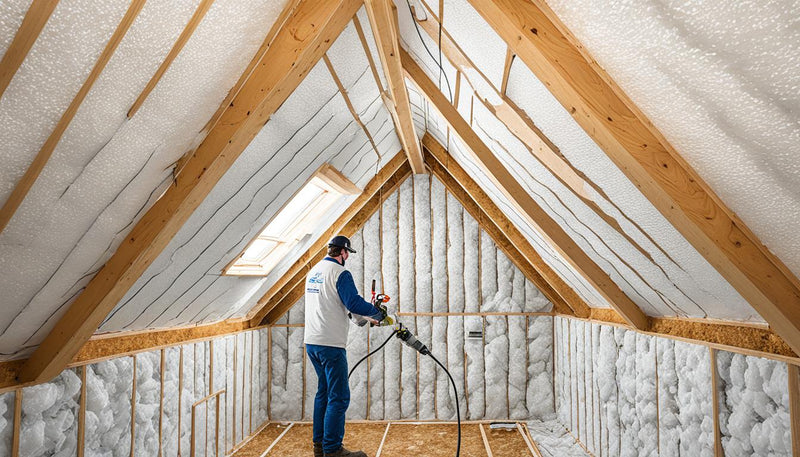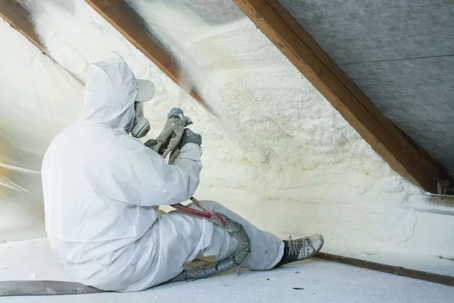Contrasting Spray Foam to Standard Insulation: Which Is Much better?
Contrasting Spray Foam to Standard Insulation: Which Is Much better?
Blog Article
Spray Foam: The Ultimate Service for Air Sealing and Insulation
Spray foam insulation has actually become a leading service for efficient air securing and thermal insulation, offering a special mix of homes that establish it in addition to conventional techniques. Its capability to increase and load gaps makes it particularly efficient in stopping air leak, which can dramatically impact energy efficiency. Comprehending the full range of its benefits, setup processes, and comparisons with other insulation types is vital for making educated choices. As we check out these elements, the ramifications for both new buildings and retrofits end up being increasingly significant. What factors should influence your choice?
What Is Spray Foam?
Spray foam is a functional insulation product that integrates the principles of air sealing and thermal resistance to enhance power performance in structures. Composed primarily of polyurethane or various other comparable compounds, spray foam is applied as a fluid that increases upon call with surface areas, producing a solid, continual layer of insulation. This special building allows it to fill up gaps, cracks, and gaps that standard insulation products may overlook, supplying an exceptional air seal.
There are 2 primary sorts of spray foam: open-cell and closed-cell. Open-cell spray foam is lighter and a lot more flexible, using excellent audio absorption and a lower R-value per inch - Spray Foam. On the other hand, closed-cell spray foam is denser, providing a greater R-value, wetness resistance, and included structural honesty to building elements
The application procedure normally involves specific tools, guaranteeing a smooth application that follows various substratums, consisting of concrete, wood, and steel. This versatility makes spray foam ideal for both brand-new constructions and retrofitting existing frameworks. Its capacity to create a closed barrier dramatically adds to minimizing power consumption and improving indoor air top quality, therefore making it a preferred option amongst house owners and building contractors alike.
Benefits of Spray Foam Insulation
One of the most considerable benefits of spray foam insulation is its phenomenal ability to produce a constant air obstacle, which properly minimizes energy loss. Unlike standard insulation products, spray foam broadens to load cracks and gaps, guaranteeing that air leakage is dramatically minimized. This particular not just improves power effectiveness however additionally brings about decrease energy costs with time.
Additionally, spray foam insulation offers superior thermal resistance, adding to a more secure interior setting. Its high R-value per inch enables efficient insulation in restricted spaces, making it perfect for attics, walls, and crawl rooms. The moisture-resistant residential or commercial properties of spray foam assistance stop mold and mold development, promoting much healthier living problems.
An additional important benefit of spray foam insulation is its sound-dampening qualities (Spray Foam). It properly minimizes noise transmission between areas, producing a quieter and more comfy home environment. The longevity of spray foam likewise stands out, as it does not droop or settle gradually, maintaining its efficiency throughout its lifespan
Exactly How Spray Foam Works
Comprehending just how spray foam insulation works is crucial for appreciating its performance in air sealing and thermal resistance. Spray foam insulation contains two main parts: isocyanate and polyol resin. When these elements are combined, they go through a chain reaction that causes the product to increase rapidly, developing a dense foam that fills up voids, cracks, and tooth cavities.
As the foam expands, it adheres to surfaces, developing an impermeable seal that considerably lowers air seepage. This characteristic makes spray foam insulation extremely efficient at avoiding drafts and wetness infiltration, which can lead to energy loss and damage gradually. In addition, the closed-cell variant of spray foam offers exceptional thermal resistance because of its inflexible framework, effectively minimizing heat transfer.
The distinct buildings of spray foam allow it to satisfy irregular surfaces, guaranteeing detailed protection and a smooth barrier. Because of this, spray foam insulation not only improves power performance yet likewise adds to enhanced indoor air high quality by minimizing the build-up of pollutants and irritants. Ultimately, recognizing the mechanics behind spray foam highlights its duty as a premium selection for insulation and air securing in both property and industrial applications.
Installation Refine Introduction

Before installment, the room should be appropriately cleaned and prepped, making sure that surface areas are without particles, moisture, and dust. This step is vital due to the fact that contaminants can compromise bond and general efficiency. When the area is prepared, the application includes blending both parts of the spray foam, which increases upon call and loads voids effectively.
Trained professionals should conduct the installation, utilizing specialized equipment to ensure uniform insurance coverage and website here optimum thickness. Safety preventative measures, consisting of putting on safety equipment and making sure proper ventilation, are necessary throughout this process. After application, the foam usually remedies rapidly, forming a strong obstacle that improves energy efficiency.
Contrasting Spray Foam to Standard Insulation
When examining insulation choices, spray foam insulation stands apart in comparison to typical products such as fiberglass and cellulose. One of the key benefits of spray foam is its Continue exceptional air sealing capacities. Unlike fiberglass and cellulose, which can enable air infiltration, spray foam increases upon application, filling up gaps and gaps to develop a closed seal. This results in boosted power performance, as much less heated or cooled air runs away the home, causing lower energy bills.
In addition, spray foam supplies a higher R-value per inch than standard insulation kinds, providing even more efficient thermal resistance in a thinner account. This characteristic is specifically advantageous precede with limited dental caries depth. Spray foam is resistant to wetness and mold and mildew growth, which can be a considerable problem with cellulose and fiberglass, particularly in damp settings.
However, spray foam insulation usually lugs a higher this page upfront expense than its typical equivalents. Property owners need to consider this initial investment against long-lasting power financial savings and efficiency advantages. Ultimately, while both insulation types serve their function, spray foam becomes an extra advanced solution for modern insulation requirements, especially in terms of air securing and thermal effectiveness.

Final Thought
In recap, spray foam insulation represents an extremely effective service for achieving optimal air securing and thermal resistance. Its one-of-a-kind properties, including dampness resistance and audio dampening, make it appropriate for different applications in both new constructions and retrofitting tasks (Spray Foam). Although the first prices may be higher contrasted to typical insulation products, the long-term benefits, such as substantial power cost savings and improved interior air high quality, justify the investment and emphasize its value in modern structure methods.
Spray foam insulation has arised as a leading option for effective air securing and thermal insulation, providing an one-of-a-kind combination of homes that set it apart from traditional techniques.Spray foam is a flexible insulation product that integrates the concepts of air sealing and thermal resistance to boost energy effectiveness in buildings.When examining insulation options, spray foam insulation stands out in comparison to typical materials such as fiberglass and cellulose. Inevitably, while both insulation types serve their objective, spray foam emerges as a much more innovative remedy for modern-day insulation needs, especially in terms of air securing and thermal efficiency.
In summary, spray foam insulation stands for a highly efficient option for achieving optimal air securing and thermal resistance.
Report this page